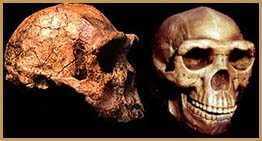
Hominid Species Time Line
Page 24
Homo erectus
Homo erectus lived from sometime after (or perhaps sometime before) 2 million years ago and survived till not very long ago. Of the earliest known species of our genus, it is viewed as the most likely to be a direct ancestor of modern humans. It competes for this honor with H. rudolfensis, H. ergaster, and H. habilis, of course; many believe erectus is descended from H. ergaster.
H. erectus was the most long-lived species in the genus Homo, and, rather than simply going extinct, appears to have evolved into several transition species or subspecies in Africa, Asia, and Europe. The remains of Homo erectus, dispersed across three continents, have also given rise to a multitude of classification issues and other controversies, as we would expect.

Classification Issues
Regarding the classification issues we noted above: scientists have questioned whether it is appropriate to use the same species name for a population distributed from Africa to Asia and Europe over a period of almost two million years. The original species description of H. erectus was based on the Asian specimens from China and Indonesia. The skull above right is a composite reconstructed from the remains of several individuals from China. The skull above left was found in Africa, and is somewhat older. The two possess significant differences.
Scientists also doubt that such a far-flung distribution would have permitted a single, interactive breeding community (the fundamental characteristic of a species), and so the earliest African specimens are now called H. ergaster. Some scientists use the combined appellation ergaster/erectus to acknowledge their uncertainty about the matter and the close kinship of the two groups.
The emergence and extinction dates of this species are also blurred by the classification issues. Currently, new discoveries, along with new dating techniques used on old specimens, are pushing the origin of Homo erectus back well beyond 2 million years ago. While still controversial, these new dating techniques make some specimens found in Asia appear much older than previously thought.
The conventional view holds that the earliest appearance of Homo erectus-like individuals was in Africa, and that the basic type persisted there for almost two million years. But if Homo erectus was in east Asia well before 2 million years ago, all chronological bets are off.
Many Homo erectus remains have been found in eastern and southern Asia. Stone tools dating to 2.25 million years ago have been found at Renzi cave in central China, upsetting all the conventional time lines. (This date is contested, of course.) The makers of the tools are not known, but they would almost certainly be ancestors of erectus whether they were of habilis, ergaster, or georgicus stock. Discoveries of skeletal remains in China classified as H. erectus range in recent estimates from 1.9 million years in age (Longgupo), to 1.8 million years (Nihewan), to @ 0.7 million years at Lantian and Nanjing, to 0.4 million years in age at Zhoukoudian (the former “Peking Man”). Remains at Liujiang may be only 70,000 years old, demonstrating the remarkable persistence of this species in Asia.
In Indonesia, the original “Java Man” discovered in 1891 by Eugene DuBois has been recently re-dated to around 1.6 million years in age. This date, and the earliest Chinese dates above, establish an early migration out of Africa some time before 2 million years ago. Damanisi Man—Homo georgicus—resident in the Caucasus around 1.8 million years ago, further complicates the picture.
In Europe, two species, one found at Heidelberg, H. Heidelbergensis, approximately 500,000 years old, and another, H. antecessor, excavated from a strange burial trove in Sierra de Atapuerca in Spain and dating to 780,000 years ago, are variously seen as separate species or regional subtypes of Homo erectus. Close relationship among these groups is not in question.
As to this species’ “expiration date,” recent discoveries show that Homo erectus persisted in Asia, both in China and Indonesia, until 70,000, or perhaps even 50,000 years ago. The diminutive H. Floresiensis, nicknamed the Hobbit, recently discovered in Indonesia, appears to be a dwarf sub-species of erectus that survived until about 18,000 years ago.
Because of classification issues, it is difficult to pinpoint when late Homo erectus becomes early (or archaic) Homo sapiens. Are discoveries such as the ones at Arago or Petaluna subspecies of Homo sapiens? Or should they be classified as subspecies of Homo erectus? Recently, a previously known species, H. heidelbergensis and a new one identified in Spain, H. antecessor, have been expanded to absorb most of the specimens in Europe and Africa formerly classified as early Homo sapiens.
Suffice it to say that our present classifications of the genus Homo are in flux and likely to change as we acquire new knowledge. For the lay person interested in the subject of human evolution, rather than sort through the positions in the classification wars, it is probably more instructive to leaf through one of the lavishly illustrated books on human evolution (e.g., From Lucy to Language, by Donald Johanson and Blake Edgar [Simon & Shuster, revised edition, 2006]. Even an untrained eye can see the evolutionary divergences of the Paranthropus species and the gradual progression toward more modern humans in the Homo species.
References:
Homo erectus on TalkOrigins.org